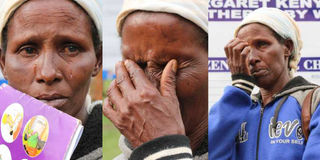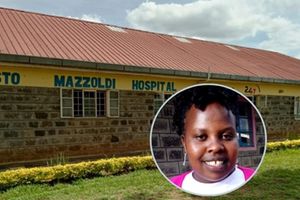
Anna Cheptonui,50, weeps outside the Margaret Kenyatta Mother Baby wing in Nakuru County Referral and Teaching Hospital on October 2, 2024 after her 18 year-old daughter who had given birth at the facility under the Linda Mama programme was detained until she pays Sh7,500.
In the dimly lit corridors of Jaramogi Oginga Odinga Teaching and Referral Hospital, Rose Joan Auma sits motionless, her face twisted in pain. She holds her swollen jaw, waiting for a surgery she fears may never come.
Her condition worsens by the hour, but she is optimistic that the hospital administration will listen and attend to her. She pleaded with them but this goes unheard.
Esther's surgery was scheduled days prior, but without a functioning health insurance system, she remains a prisoner of pain.
“I haven’t eaten for two days. They keep saying I’ll go into surgery, but nothing happens. I’m scared,” she says, her voice barely above a whisper.
Her hope is slipping away.
The resident of Rabuor, Kisumu County was scheduled for surgery on October 1, at the facility, she was helped to register under Social Health Authority (SHA), and would later receive a confirmation text on her phone.
However, this is yet to be reflected in the hospital system since the system was not operational.
She pitched tent at the facility billing station hoping to be helped but did not receive any communication by evening. She went back home. This was the first day.
“I was later informed that I could not be scheduled for surgery or any services since the SHA system was not operational," she says.
'I'm in so much pain'
On October 2, she once again made her way to the regional facility but was told the scheduled surgery could not take place since the system was still down.
"I am in so much pain but the doctors have not attended to me. I have been given an option to pay in cash but I don't have a single coin with me," said a teary Ms Auma in her hospital bed.
“I also have no one to take care of my financial needs, all my hopes were on the NHIF card," she said.
She is trapped in a nightmarish reality shared by thousands of Kenyans stranded in hospitals due to the collapse of the Social Health Authority (SHA).
All across the country, patients like Esther are enduring a medical crisis of unspeakable horror. Kenya’s SHA, responsible for covering healthcare costs, is still a work in progress.
With no coverage, hospitals refuse to discharge patients or offer essential treatments, leaving many stranded in wards that are overcrowded, understaffed, and ill-equipped to handle the influx of patients.

Jaramogi Oginga Odinga Teaching and Referral Hospital in Kisumu County.
In a system meant to safeguard public health, it’s the poor and the vulnerable who suffer the most. Those unable to pay are left in limbo — unable to leave, unable to afford treatment, and with no clear path forward.
New mums' woes
New mothers are unable to leave maternity wards, reason, their National health insurance cards have been disabled and they are unable to afford their bills for them to be discharged.
One of them, Joyce Wambui, who requested the name of the hospital not to be mentioned for fear of being victimized, gave birth normally on Monday, a night before the rollout of SHA.
Her baby is healthy, but she remains barred from leaving the hospital because she is newly registered and her registration is yet to go through.
“I was scheduled for a discharge today but I can’t go home because I have to clear the bill. I don’t even know whether the registration is done it will be able to clear the bills. I have requested my family to start looking for the money lest we pay a huge bill which we had not planned for,” Ms Wambui said.
She says: “I just want to take my baby home,” she says, her eyes welling up with tears. “But they won’t let me go. Every day I stay here, the bill grows. I don’t know how I’ll pay it.”
Within the female wards, Ms Ann Akinyi, despite being discharged, could not leave the facility.
The 36-year-old said her bill of Sh21,000 was not yet settled and had been told that her NHIF card was no longer operational.
Salivary glands blocked. There was a hole in the food pipe, the surgery was done, but I cannot be discharged.
"I instructed my daughter to have me registered in the new system. Although we have been successful, I am told the system is not working yet," she said.
Mr John Okello also visited the regional facility to clear the pending hospital bill of a deceased relative who succumbed while undergoing treatment at the facility.
Mr Okello explained that they had expected to clear the pending treatment bill using the deceased NHIF card but that had not been possible.
“I have been here since 9 am but was told that the system is still low and that I should come back in two to three days,” says Mr Okello adding that plans were underway to remove the kin's body from the hospital morgue on Friday but they are yet to clear a treatment bill worth Sh18,000.
Critical condition
For patients in critical condition, the situation is life-threatening. For two days, John Kamau, an elderly man with severe kidney failure, has been waiting for dialysis. His family, helpless to intervene, watches in despair as his health deteriorates.
"His insurance hasn’t been processed, so they refuse to treat him. We’ve begged for help, but they won’t listen. We’re watching him die," says his daughter, her voice trembling with emotion.
Doctors are unable to treat patients without the green light from the SHA.
Read: The problem with SHIF
At the Jaramogi Oginga Odinga Teaching and Referral Hospital (JOOTRH) tens of patients were stranded while the hospital official said both NHIF and SHA systems remained low.
According to the hospital junior staff who cannot be quoted, the new system has not been working since October 1 and resulted in delays in admissions, treatment and discharge of patients.
The facility was also not able to book any surgeries patients were asked to wait or check with the hospital the following day.
“A number of our patients have been crowded at the billing department while some have been forced to pay from their pockets,” said the official.
Acting SHA CEO Elijah Wachira has apologized to Kenyans admitting to ‘technology problems that have since crippled SHIF leaving thousands of patients around the country stranded and in pain.
But what exactly happened to the much-touted SHA system peddled by the government as the best thing next to a slice of bread?
While addressing governors from various counties in Naivasha on Wednesday led by Council of Governors (CoG) health committee chairperson Muthomi Njuki, Mr Wachira explained that before the rollout, a lot of development work had been happening to ensure the right connectivity.
“As fate would have it, CT has a way of not delivering when you need it to behave the most. I have ever gone to make a presentation and it is only at that time that the projector decides not to work,“ he told governors.
The acting CEO said that their technical team had invested a lot of effort in ensuring that the systems were ready.
“Not only to register Kenyans but further to recognize them when they go to hospitals, and submit the claims to be ready for payment. That is what I had been shown by a government agency called Digital Health Agency (DHA) that is indeed coordinating this,“ he said.
“Yesterday we commenced the rollout of SHIF and called upon Kenyans to go out and register, a process I would say was successful up to 80 per cent. Why I am not giving it 100 per cent is because it was evident that when many people tried to get into the system, the system got clogged and some of the registration exercises were not successful,“ the CEO added.
“They expanded the bandwidth so that it can accept more information, process and release and as a result registration stabilized at one point which is why we were able to progress. We were able to migrate about 9 million Kenyans from the National Hospital Insurance Fund(NHIF) system, “he disclosed.
The acting CEO further pointed out one of their biggest headaches.
“When someone ‘got queued’ to register digitally, many of them tried again and again and again and so if there was ten of us trying to register at the same time and were trying many times with some doing 70 to 100 attempts, that caused more confusion in the system which we addressed by sending text messages to Kenyans who were doing so to tell them we have received, we are processing, relax, we shall get back to you.”
Secondly, Mr Wachira admits that the claims processing system was not able to work as envisioned which means the biometrics were indeed not working.
“We had patients on dialysis, patients who required chemotherapy and expectant mothers that required urgent attention and so what I did immediately was to write from Kakamega where I was overseeing the roll out and committed to private and public hospitals that the government and SHA will be able to settle all those claims because we are not going to sit and watch Kenyans die. Of course, there’s what I can do from a policy perspective and what I can escalate, I escalated it to the SHA board, the health ministry as well as the head of the public service,” Mr Wachira told governors adding that they have a meeting on Wednesday at 4.30pm over the matter so that all the issues they are grappling with will be sorted as they aim to make a policy decision.
However, Jacob Omondi, chairman Siaya Bunge la Wananchi blames the government for what he termed as a hasty transition.
"The common person, who is at the center of all these is not aware of the transition. The majority are still holding on to the NHIF. We need more public engagement and participation on this," he said.
A visit to Murang'a Level Four as well as Maragua Level Four hospitals found confused patients queuing but being advised to have cash in hand for services.
"I am here to settle the bill for my wife who has given birth. I thought I was home and dry by having an up-to-date NHIF card but I have been told that it is now meaningless. I have to pay the Sh32,000 bill," said Shadrach Muema, 43.
A medic at Muriranjas Level Four hospital termed the transition as "headless, tailless and limbless with patients firmly in the dark, county government telling us to assist the patients with registration yet that is not part of our work".
Speaking to Nation in an interview over concerns raised by hospital administrators around the country who are members of the Kenya Medical Practitioners Pharmacist & Dentist Union, Dr Bill Muriuki, the secretary general of KMPDU Central Branch said that the SHIF rollout has faced significant challenges due to a lack of clarity in both its structure and implementation.
“One of the most critical issues is the absence of clear contractual agreements between SHIF and healthcare facilities as many administrators, who are our members, have raised concerns about who will reimburse their facilities, given that SHA has yet to officially recognize or contract with these institutions. This uncertainty has hampered planning and disrupted healthcare delivery, particularly at primary care levels, from dispensaries to Level 5 facilities,” he told Nation on Wednesday.
According to Dr Muriuki, a hospital administrator in one of Kiambu County’s key facilities shared with him their frustration about turning away patients who expected SHIF to cover their care, only to discover that no such systems exist yet.
“It’s an untenable situation for administrators and healthcare workers alike, as they are left in the dark without any guidance or support from the authorities.”
In an interview, Beatrice Kairu, a Kenyan health economist said that while the demand for health services is still on the rise, especially for terminally illpatients the transition of SHA was poorly carried out with poor coordination of both the supply and the demand side.
“On the supply side here being the healthcare providers SHA did not engage the providers for a smooth transition. The providers had not signed their contracts with SHA and many were disgruntled by the new benefit packages being provided as it was lower than what NHIF super cover was providing,” she highlighted.
“SHA did not factor in recommendations given to them by the Kenya Medical Association as well as nursing associations who represent the majority of the providers and their memorandums were not factored in. Also, NHIF owed the providers over Sh29 billion and there is no clear communication on how they are going to be paid now that SHA has come on board hence they prefer patients pay them in cash, which is why hospital administrators are hesitant to sign SHA contracts,” she told Nation.
Reporting by Angeline Ochieng, Leon Lidigu, Angela Oketch











